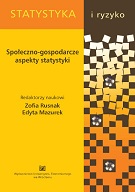National Welfare Index – ocena nowego miernika rozwoju trwałego i zrównoważonego
National Welfare Index – assessment of a new measure of sustainable development
Author(s): Jerzy ŚleszyńskiSubject(s): Economy
Published by: Wydawnictwo Uniwersytetu Ekonomicznego we Wrocławiu
Keywords: sustainable development; synthetic indicators; National Welfare Index
Summary/Abstract: Since the nineties scientists researching relationship between socio-economic system and its natural environment have produced a lot of statistical methods and measures to monitor feedbacks and impacts. Among them are synthetic indicators representing in a single number the complex and multidimensional development issue which is called sustainable development. Synthetic indicators of sustainable development aggregate factors suggested by the document “Agenda 21” as those that contribute to a long-term strategy of harmonization of economic, social, and environmental aspects of human activity. Sustainability indicators formulated in monetary terms are those of synthetic indicators which are the nearest to the economic mainstream theory. They are using typical economic categories measuring economic welfare but also modified and supplementary categories not present in the national accounting. Invented in Heidelberg National Welfare Indicator belongs to this group of indicators and, in fact, it is a continuation of theoretical and calculation work which resulted earlier in American publications on the Index of Sustainable Economic Welfare and on the Genuine Progress Indicators. NWI indicator requires statistical data on the national economy level relating to the individual consumption, public expenditures, and selected non-market activities increasing or decreasing the level of welfare. The sum of positive factors has to be revised by taking into account monetary effects of phenomena like natural and social environment degradation and economic inefficiency which tend to reduce the level of welfare. A critical discussion in the article is focused on the structure and categories of NWI and allows to understand difficulties of measuring the welfare. In addition, SWAP analysis suggests to what extent NWI can be considered as the indicator of national sustainable development. Finally, the promising results of NWI development for Germany are supplemented by remarks on potential applicability of this indicator to Polish conditions.
Journal: Prace Naukowe Uniwersytetu Ekonomicznego we Wrocławiu
- Issue Year: 2013
- Issue No: 309
- Page Range: 236-260
- Page Count: 25
- Language: Polish

